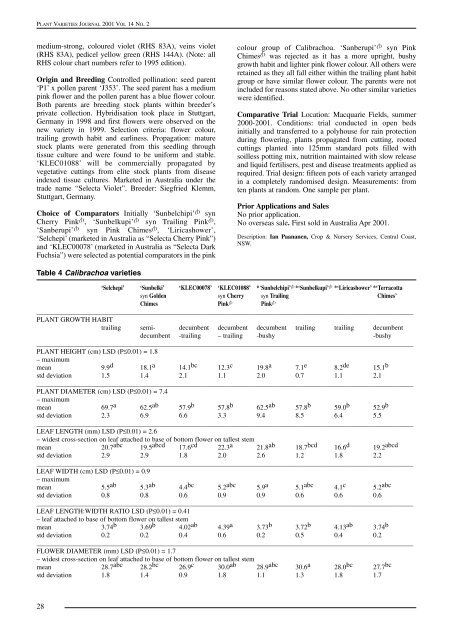47. Volume 14- Number 2 - IP Australia
47. Volume 14- Number 2 - IP Australia
47. Volume 14- Number 2 - IP Australia
You also want an ePaper? Increase the reach of your titles
YUMPU automatically turns print PDFs into web optimized ePapers that Google loves.
PLANT VARIETIES JOURNAL 2001 VOL <strong>14</strong> NO. 2<br />
medium-strong, coloured violet (RHS 83A), veins violet<br />
(RHS 83A), pedicel yellow green (RHS <strong>14</strong>4A). (Note: all<br />
RHS colour chart numbers refer to 1995 edition).<br />
Origin and Breeding Controlled pollination: seed parent<br />
‘P1’ x pollen parent ‘J353’. The seed parent has a medium<br />
pink flower and the pollen parent has a blue flower colour.<br />
Both parents are breeding stock plants within breeder’s<br />
private collection. Hybridisation took place in Stuttgart,<br />
Germany in 1998 and first flowers were observed on the<br />
new variety in 1999. Selection criteria: flower colour,<br />
trailing growth habit and earliness. Propagation: mature<br />
stock plants were generated from this seedling through<br />
tissue culture and were found to be uniform and stable.<br />
‘KLEC01088’ will be commercially propagated by<br />
vegetative cuttings from elite stock plants from disease<br />
indexed tissue cultures. Marketed in <strong>Australia</strong> under the<br />
trade name “Selecta Violet”. Breeder: Siegfried Klemm,<br />
Stuttgart, Germany.<br />
Choice of Comparators Initially ‘Sunbelchipi’ A syn<br />
Cherry Pink A , ‘Sunbelkupi’ A syn Trailing Pink A ,<br />
‘Sanberupi’ A syn Pink Chimes A , ‘Liricashower’,<br />
‘Selchepi’ (marketed in <strong>Australia</strong> as “Selecta Cherry Pink”)<br />
and ‘KLEC00078’ (marketed in <strong>Australia</strong> as “Selecta Dark<br />
Fuchsia”) were selected as potential comparators in the pink<br />
Table 4 Calibrachoa varieties<br />
28<br />
colour group of Calibrachoa. ‘Sanberupi’ A syn Pink<br />
Chimes A was rejected as it has a more upright, bushy<br />
growth habit and lighter pink flower colour. All others were<br />
retained as they all fall either within the trailing plant habit<br />
group or have similar flower colour. The parents were not<br />
included for reasons stated above. No other similar varieties<br />
were identified.<br />
Comparative Trial Location: Macquarie Fields, summer<br />
2000-2001. Conditions: trial conducted in open beds<br />
initially and transferred to a polyhouse for rain protection<br />
during flowering, plants propagated from cutting, rooted<br />
cuttings planted into 125mm standard pots filled with<br />
soilless potting mix, nutrition maintained with slow release<br />
and liquid fertilisers, pest and disease treatments applied as<br />
required. Trial design: fifteen pots of each variety arranged<br />
in a completely randomised design. Measurements: from<br />
ten plants at random. One sample per plant.<br />
Prior Applications and Sales<br />
No prior application.<br />
No overseas sale. First sold in <strong>Australia</strong> Apr 2001.<br />
Description: Ian Paananen, Crop & Nursery Services, Central Coast,<br />
NSW.<br />
‘Selchepi’ ‘Sunbelki’ ‘KLEC00078’ ‘KLEC01088’ *‘Sunbelchipi’ A *‘Sunbelkupi’ A *‘Liricashower’ *‘Terracotta<br />
syn Golden syn Cherry syn Trailing Chimes’<br />
Chimes Pink A Pink A<br />
______________________________________________________________________________________________________________<br />
PLANT GROWTH HABIT<br />
trailing semi- decumbent decumbent decumbent trailing trailing decumbent<br />
decumbent -trailing – trailing -bushy -bushy<br />
______________________________________________________________________________________________________________<br />
PLANT HEIGHT (cm) LSD (P≤0.01) = 1.8<br />
– maximum<br />
mean 9.9 d 18.1 a <strong>14</strong>.1 bc 12.3 c 19.8 a 7.1 e 8.2 de 15.1 b<br />
std deviation 1.5 1.4 2.1 1.1 2.0 0.7 1.1 2.1<br />
______________________________________________________________________________________________________________<br />
PLANT DIAMETER (cm) LSD (P≤0.01) = 7.4<br />
– maximum<br />
mean 69.7 a 62.5 ab 57.9 b 57.8 b 62.5 ab 57.8 b 59.0 b 52.9 b<br />
std deviation 2.3 6.9 6.6 3.3 9.4 8.5 6.4 5.5<br />
______________________________________________________________________________________________________________<br />
LEAF LENGTH (mm) LSD (P≤0.01) = 2.6<br />
– widest cross-section on leaf attached to base of bottom flower on tallest stem<br />
mean 20.7 abc 19.5 abcd 17.6 cd 22.3 a 21.8 ab 18.7 bcd 16.6 d 19.2 abcd<br />
std deviation 2.9 2.9 1.8 2.0 2.6 1.2 1.8 2.2<br />
______________________________________________________________________________________________________________<br />
LEAF WIDTH (cm) LSD (P≤0.01) = 0.9<br />
– maximum<br />
mean 5.5 ab 5.3 ab 4.4 bc 5.2 abc 5.9 a 5.1 abc 4.1 c 5.2 abc<br />
std deviation 0.8 0.8 0.6 0.9 0.9 0.6 0.6 0.6<br />
______________________________________________________________________________________________________________<br />
LEAF LENGTH:WIDTH RATIO LSD (P≤0.01) = 0.41<br />
– leaf attached to base of bottom flower on tallest stem<br />
mean 3.74 b 3.69 b 4.02 ab 4.39 a 3.73 b 3.72 b 4.13 ab 3.74 b<br />
std deviation 0.2 0.2 0.4 0.6 0.2 0.5 0.4 0.2<br />
______________________________________________________________________________________________________________<br />
FLOWER DIAMETER (mm) LSD (P≤0.01) = 1.7<br />
– widest cross-section on leaf attached to base of bottom flower on tallest stem<br />
mean 28.7 abc 28.2 bc 26.9 c 30.0 ab 28.9 abc 30.6 a 28.0 bc 27.7 bc<br />
std deviation 1.8 1.4 0.9 1.8 1.1 1.3 1.8 1.7

















